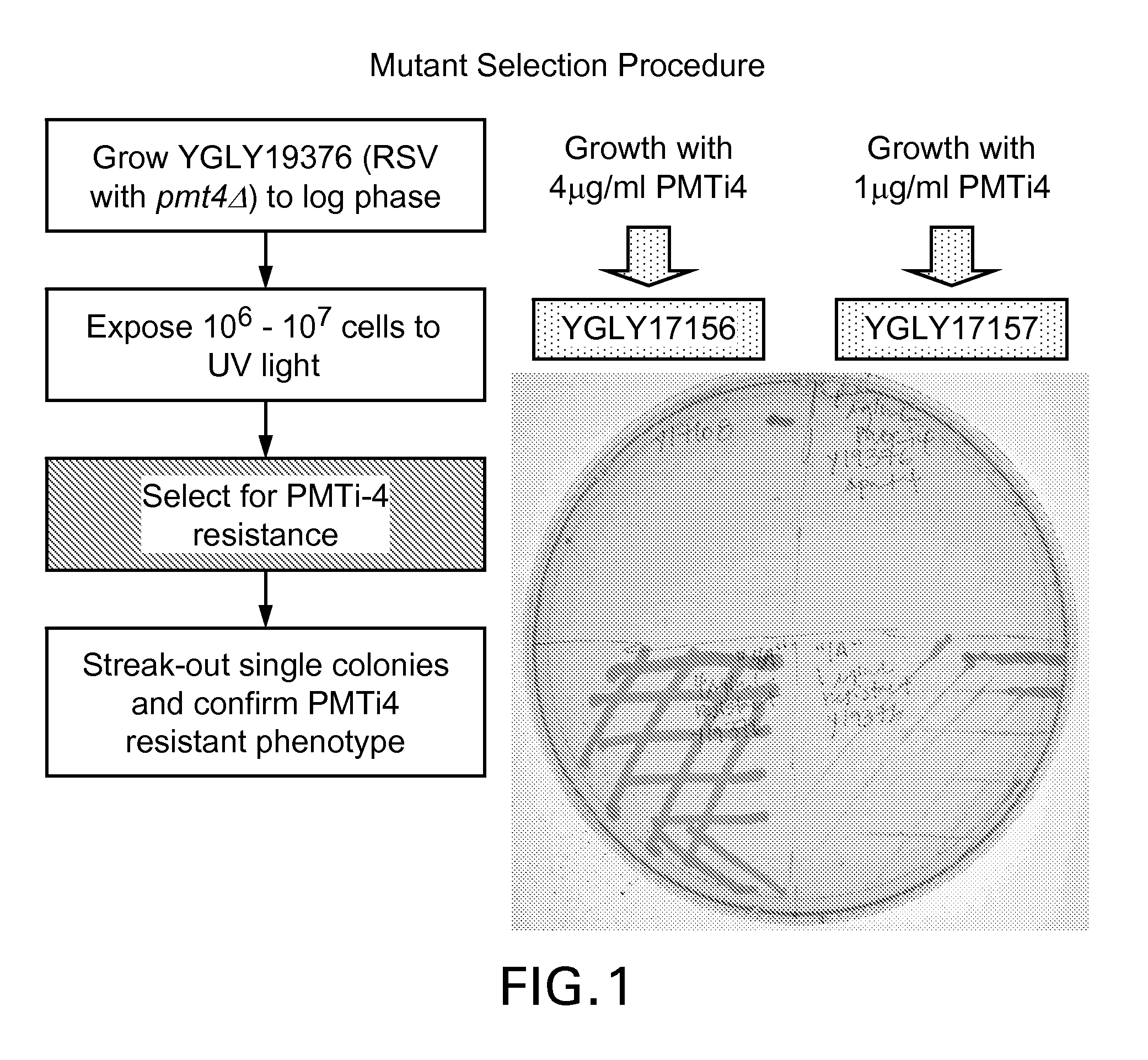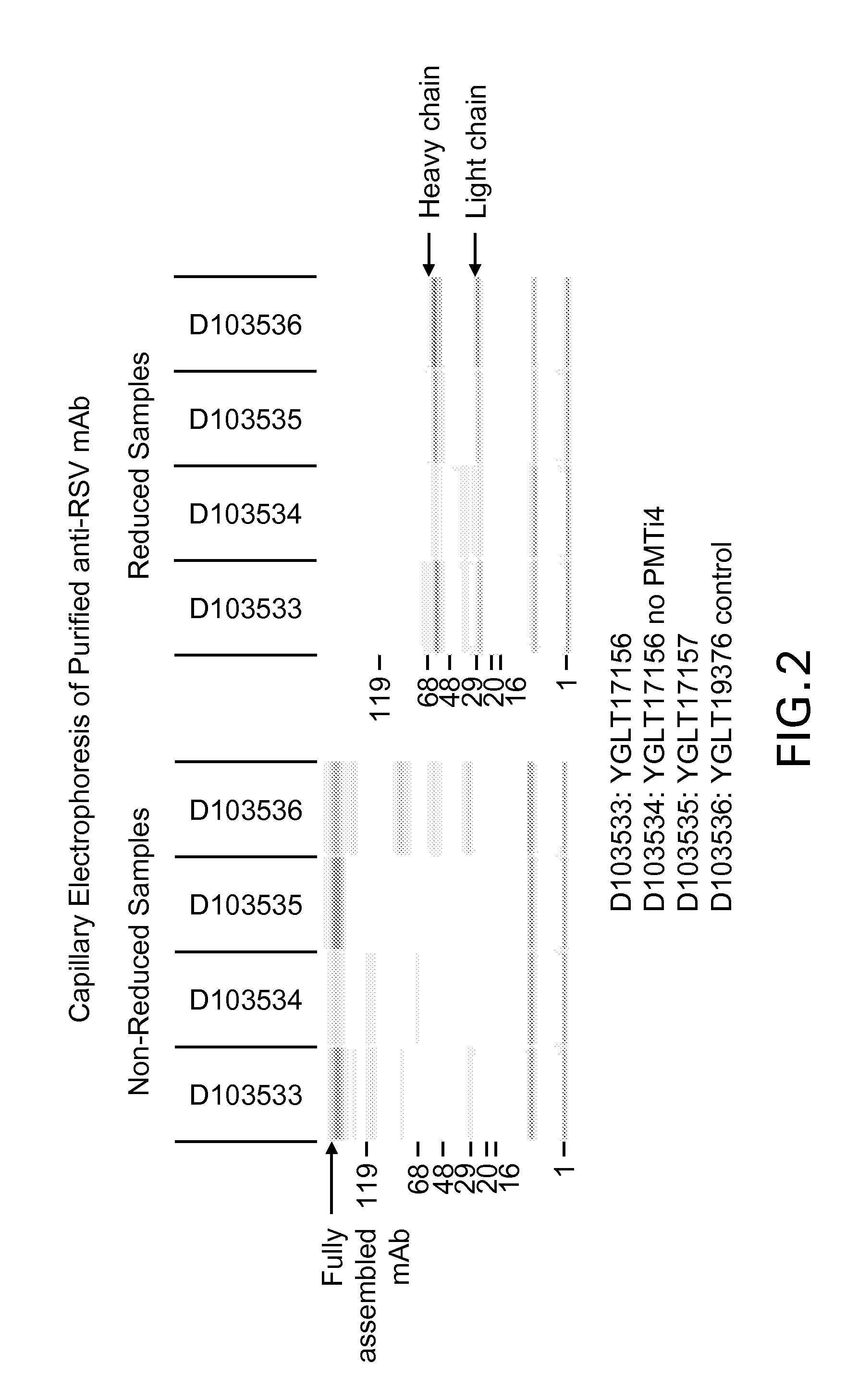Controlling o-glycosylation in lower eukaryotes
a technology of oglycosylation and host cells, which is applied in the direction of immunoglobulins, peptides, transferases, etc., can solve the problems of adversely affecting protein yield, etc., and achieves the reduction of the amount of oglycosylation, reducing the fitness or and reducing the robustness of the host cell.
- Summary
- Abstract
- Description
- Claims
- Application Information
AI Technical Summary
Benefits of technology
Problems solved by technology
Method used
Image
Examples
example 1
[0154]To identify Pichia strains more tolerant of or resistant to PMT inhibitors, we randomly mutagenized strain YGLY19376, which is a pmt4Δ host genetically engineered to produce glycoproteins with human-like glycosylation patterns and expressing a recombinant IgG1 antibody, using ultraviolet (UV) irradiation followed by subjecting the mutagenized cells to growth-inhibitory concentrations of a PMT inhibitor. Construction of strain YGLY19376 from wild-type Pichia pastoris is described in example 2.
[0155]UV mutagenesis was performed as described by Winston (Curr. Protoc. Mol. Biol. 82:13.3B.1-13.3B.5 (2008)). Briefly, Pichia pastoris strain YGLY19376 (GFI5.0, pmt4Δ, expressing a recombinant IgG1) was grown in 40 mL YSD liquid medium over night at 24° C. Upon reaching an OD600 of five, a 10 mL aliquot of culture was transferred into an empty 100 mm sterile Petri dish, and treated, with the lid off, with 12 mJ / cm2 of UV irradiation. After the UV treatment, the Petri dish was immediatel...
example 2
[0166]The parent strain YGLY19376 in Example 1 was constructed from wild-type Pichia pastoris strain NRRL-Y 11430 using methods described earlier (See for example, U.S. Pat. No. 7,449,308; U.S. Pat. No. 7,479,389; U.S. Published Application No. 20090124000; Published PCT Application No. WO2009085135; Nett and Gerngross, Yeast 20:1279 (2003); Choi et al., Proc. Natl. Acad. Sci. USA 100:5022 (2003); Hamilton et al., Science 301:1244 (2003)). All plasmids were made in a pUC19 plasmid using standard molecular biology procedures. For nucleotide sequences that were optimized for expression in P. pastoris, the native nucleotide sequences were analyzed by the GENEOPTIMIZER software (GeneArt, Regensburg, Germany) and the results used to generate nucleotide sequences in which the codons were optimized for P. pastoris expression. Yeast strains were transformed by electroporation (using standard techniques as recommended by the manufacturer of the electroporator BioRad).
[0167]From a series of t...
example 3
[0172]In this example the underlying nucleotide alterations that are responsible for the PMT inhibitor-resistant phenotype were identified.
[0173]The PMTi-4 inhibitor used to produce the mutant strains in Example 1 is a close chemical analogue of the rhodanine-3-acetic acid derivatives that were originally identified as potent in vitro inhibitors of the Candidas albican Pmt1p protein (U.S. Pat. No. 7,105,554; U.S. Published Application No. 20110076721). Since then, it has been shown that in Saccharomyces cerevisiae these rhodanine-3-acetic acid derivatives also inhibited Pmtp proteins encoded by other PMT genes, for example, Pmt2p, Pmt4p, and Pmt6p (Arroyo et al., Mol. Microbiol. 79(6): 1529-1546 (2011)).
[0174]To examine if any of the PMT genes in our PMT inhibitor-resistant mutants were mutated by the UV treatment, the PMT1, PMT2, and PMT6 genes were PCR-amplified from the genomic DNA isolated from the mutant strains YGLY17156 and YGLY17157 (the PMT4 gene has been previously deleted...
PUM
| Property | Measurement | Unit |
|---|---|---|
| mole percent | aaaaa | aaaaa |
| mole percent | aaaaa | aaaaa |
| mole percent | aaaaa | aaaaa |
Abstract
Description
Claims
Application Information
 Login to View More
Login to View More - R&D
- Intellectual Property
- Life Sciences
- Materials
- Tech Scout
- Unparalleled Data Quality
- Higher Quality Content
- 60% Fewer Hallucinations
Browse by: Latest US Patents, China's latest patents, Technical Efficacy Thesaurus, Application Domain, Technology Topic, Popular Technical Reports.
© 2025 PatSnap. All rights reserved.Legal|Privacy policy|Modern Slavery Act Transparency Statement|Sitemap|About US| Contact US: help@patsnap.com



